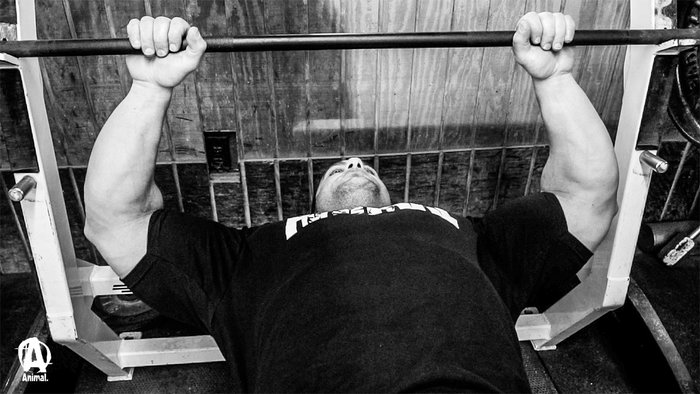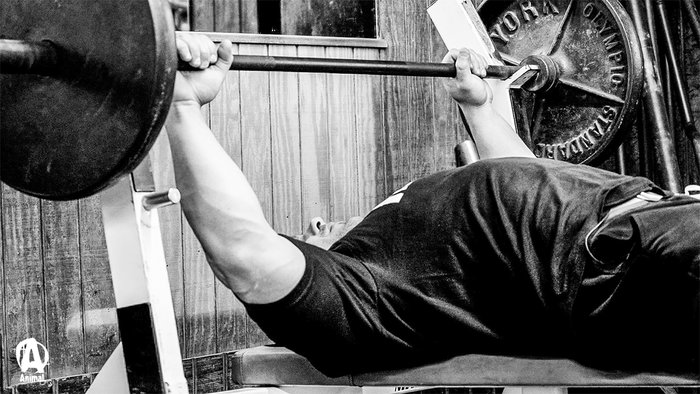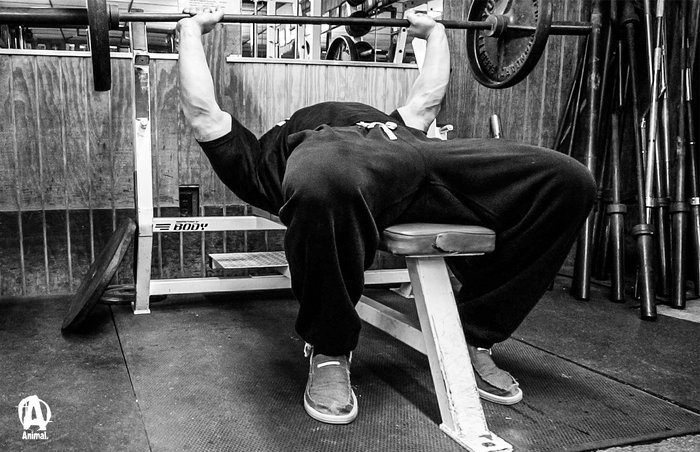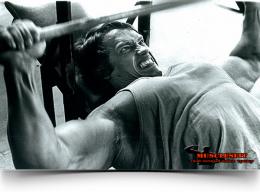The correct technique for performing a barbell press while lying on a horizontal bench
The bench press from the chest is an exercise aimed at working the entire chest. In this exercise, all three zones of the pectoral muscles (top, middle and bottom) are included in the slave. In addition, many auxiliary groups are also involved in the work. This movement is the most basic bodybuilding exercise for the chest muscles.
This guide will help you learn how to do the bench press with a barbell correctly and achieve high results in gaining mass and strength. Lower your feet from the bench to the floor, sit back, squeeze your shoulder blades together and grab the bar with a closed grip.
The most famous exercise of the three that weightlifters perform to develop strength and gain mass in the pectoral muscles is the bench press. It's easy to do, isn't it? All you have to do is lie down on the bench, take the barbell off the rack and not think about anything... until you hurt yourself.
Attention: in order to lift heavy weights, it must be lifted correctly.
Below are 5 points, by paying attention to which, you can develop the muscles of the chest, arms and even back and, therefore, become much stronger. However, think carefully: if you do not want your upper body to be more developed in relation to your whole body, it is better to do fitness.
Lie down on a bench so that your eyes are level with the barbell. Press your buttocks and lower back into the bench and do not lift them throughout the entire exercise. Place your feet on the floor.
Take the bar with a grip slightly wider than shoulder-width and remove it from the rack. Begin to lower the barbell under control to the level of your lower chest.
Lower the bar until you touch your chest, then press the weight upward with force.
Keep your arms at approximately a 45-degree angle to your body. Do not press your elbows to your body or spread them too far to the sides. The horizontal barbell press is an exercise that should not be rushed or done at speed, otherwise you may get injured.
Also watch your breathing, as you inhale, lower the projectile down, as you exhale, squeeze it out.
- The bench press is an exercise in which an extra safety net doesn’t hurt. Therefore, if you are training with a partner, always ask him to back you up. If you are alone, then ask someone from the audience. Do not be shy.
- Sometimes your hands get sweaty and start to move apart, which throws you off your concentration. To avoid this, you can smear your hands with chalk.
1. Watch your grip
First of all, let's figure out how to properly grip the barbell when bench pressing, despite the fact that the width of your grip is mostly a matter of personal preference, a clearly adjusted distance will distribute the load on the shoulders and muscles of the chest and arms correctly. A grip that is too wide will put unnecessary stress on your shoulders; A grip that is too narrow can be hard on your elbows.

Unfortunately, the grip that is ideal for you may not be ideal for someone else. Experiment until you find the optimal width for you. If you feel pain in your shoulders or elbows, your grip is either too wide or too narrow.
Next: To make your grip more comfortable, you can hold the barbell with your thumb on top, or use an “open grip,” also called a “suicide grip.” Here again, the choice is yours, but with an “open grip,” as I have seen from my own experience, it creates a strong load on the wrists. I still recommend gripping the bar, covering it with your thumb on top so that you can hold the barbell as firmly as possible.
2. Arch your back
To get the most benefit from the bench press, you need to arch your back during the exercise. Thus, the load will move to the upper back and trapezius muscle. You will feel the need to squeeze your shoulder blades, as if touching one shoulder blade to the other. This makes a huge difference in lifting heavy weights and staying safe during your workout.

If you lie on a bench with a flat back, without arching it or squeezing your shoulder blades, most of the work will be done by your arms and shoulders, while the pectoral muscles will practically not participate in the movement. Your shoulders won't thank you for this. This method will produce a weak bench press and you will end up with underdeveloped pecs.
3. No need to place your elbows too far to the sides
Now that your grip is correct, your back is arched, and your shoulder blades are retracted, it’s time to remove the barbell from the supports and lower it. It is quite natural at this moment to either put your elbows out to the sides or press them closer to your body. If they are too spaced, the load will be on the shoulders. If you keep them a little closer, the muscles of the back and chest will be involved in the movement and, accordingly, will become stronger.
With your elbows slightly closer to your body, the movement will be more productive and safer. It seems to me a good comparison of this position of the arms with the position of the legs when a person squats, if the center of gravity is transferred to the hips instead of the knees. When we do complex exercises, we always want the result to be strong ligaments and strong muscles, and to be able to calmly lift heavy weights.
4. Target – midline of the chest
Now let's talk about where the bar should be when you lower it to your chest. You want to make sure that at the lowest point of the movement you don't push it too close to the neck or push it too far away. Many old school bodybuilders bring the bar close to their throat, which forces them to push their elbows out to the sides. For most of us, this often feels unnatural: it reduces the amount of weight you can lift and increases the risk of shoulder injury.
On the other hand, if you lower the bar too far towards the middle of your torso, you risk losing control of the bar. For best results, the bar should be lowered directly to the nipple line. This will help you keep your elbows in the right position, distribute tension correctly during the downward movement, and help you push upward.

Always lower the bar until it touches your chest. There's no point in stopping at the bottom. Full muscle development depends on proper movements.
5. Don't stop at the top
Now that you know the basic mechanics of the barbell press movement, the only thing left to talk about is how to press it up. Keep your chest high, elbows in the correct position, and shoulder blades squeezed. Use your back and chest muscles to push the barbell toward the ceiling.
If you are lifting weights to develop muscle, or you are a bodybuilder, I advise you not to stop at the top of the movement. By eliminating even a short stop, we ensure constant tension in the chest muscles and minimize stress on the elbows.
If you are a powerlifter, follow the requirements of your sport. If you just want to be strong and look cool, take the above into account and make the most of your next workout!
Errors in the exercise
- Lumbar arch or “bridge”. It is usually used by powerlifters to achieve greater strength gains because in this position, you begin to press with your entire body, not just your chest muscles. But if your goal is to gain muscle mass, then avoid arching your lower back and work only with your chest muscles.
- Arms are strongly spread to the sides. This position creates additional stress on the shoulder joints, which is good.
- Lowering the barbell closer to the throat. In this version, the upper chest, triceps and shoulders begin to work more.
- Execution at incomplete amplitude. With this performance, you do not stretch the muscle enough, thereby reducing the effect of the exercise.
Execution options:
- Narrow grip
- Head down
This exercise is a fundamental difference in technique for powerlifters and bodybuilders. These two videos tell you how to correctly do the bench press with a barbell in different styles for different purposes and how one technique differs from another.
Powerlifting technique - video
Nuances of technique in bodybuilding
Important! To prevent injury, follow proper barbell press technique.
Video about the correct barbell press technique






